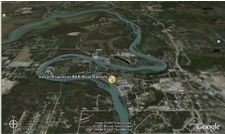 |
The Chinook salmon (Oncorhynchus tshawytscha) is Alaska's state fish and is one of the most important sport and commercial fish native to the Pacific coast of North America. It is the largest of all Pacific salmon, with weights of individual fish commonly exceeding 30 pounds. A 126-pound Chinook salmon taken in a fish trap near Petersburg, Alaska in 1949 is the largest on record. The largest sport-caught Chinook salmon was a 97-pound fish taken in the Kenai River in 1986.
The Chinook salmon has numerous local names. In Washington and Oregon, Chinook salmon are called Chinook, while in British Columbia they are called spring salmon. Other names are quinnat, tyee, tule, blackmouth, and king.
Range: In North America, Chinook salmon range from the Monterey Bay area of California to the Chukchi Sea area of Alaska. On the Asian coast, Chinook salmon occur from the Anadyr River area of Siberia southward to Hokkaido, Japan.
In Alaska, it is abundant from the southeastern panhandle to the Yukon River. Major populations return to the Yukon, Kuskokwim, Nushagak, Susitna, Kenai, Copper, Alsek, Taku, and Stikine rivers. Important runs also occur in many smaller streams.
General description: Adults are distinguished by the black irregular spotting on the back and dorsal fins and on both lobes of the caudal or tail fin. Chinook salmon also have a black pigment along the gum line which gives them the name "blackmouth" in some areas.
In the ocean, the Chinook salmon is a robust, deep-bodied fish with a bluish-green coloration on the back which fades to a silvery color on the sides and white on the belly. Colors of spawning Chinook salmon in fresh water range from red to copper to almost black, depending on location and degree of maturation. Males are more deeply colored than the females and also are distinguished by their "ridgeback" condition and by their hooked nose or upper jaw. Juveniles in fresh water are recognized by well-developed parr marks which are bisected by the lateral line.
Life history: Like all species of Pacific salmon, Chinook salmon are anadromous. They hatch in fresh water, spend part of their life in the ocean, and then spawn in fresh water. All Chinooks die after spawning. Chinook salmon may become sexually mature from their second through seventh year, and as a result, fish in any spawning run may vary greatly in size. For example, a mature 3-year-old will probably weigh less than 4 pounds, while a mature 7-year-old may exceed 50 pounds. Females tend to be older than males at maturity. In many spawning runs, males outnumber females in all but the 6- and 7-year age groups. Small Chinooks that mature after spending only one winter in the ocean are commonly referred to as "jacks" and are usually males. Alaska streams normally receive a single run of Chinook salmon in the period from May through July.
Chinook salmon often make extensive freshwater spawning migrations to reach their home streams on some of the larger river systems. Yukon River spawners bound for the extreme headwaters in Yukon Territory, Canada, will travel more than 2,000 river miles during a 60-day period. Chinook salmon do not feed during the freshwater spawning migration, so their condition deteriorates gradually during the spawning run as they use stored body materials for energy and for the development of reproductive products.
Each female deposits from 3,000 to 14,000 eggs in several gravel nests, or redds, which she excavates in relatively deep, moving water. In Alaska, the eggs usually hatch in late winter or early spring, depending on time of spawning and water temperature. The newly hatched fish, called alevins, live in the gravel for several weeks until they gradually absorb the food in the attached yolk sac. These juveniles, called fry, wiggle up through the gravel by early spring. In Alaska, most juvenile Chinook salmon remain in fresh water until the following spring when they migrate to the ocean in their second year of life. These seaward migrants are called smolts.
Juvenile Chinooks in fresh water feed on plankton, then later eat insects. In the ocean, they eat a variety of organisms including herring, pilchard, sandlance, squid, and crustaceans. Salmon grow rapidly in the ocean and often double their weight during a single summer season.
Commercial fishery and subsistence: North Pacific Chinook salmon catches during the late 1970s and early 1980s averaged more than 4 million fish per year. The United States harvested the majority of the catch followed by Canada, Japan, and the USSR. Alaska's annual harvest during this period averaged about 731,000 fish per year, or about 32 percent of the North American catch. The majority of the Alaska catch is made in Southeast, Bristol Bay, and the Arctic-Yukon-Kuskokwim areas. Fish taken commercially average about 18 pounds. The majority of the catch is made with troll gear and gillnets.
There is an excellent market for Chinook salmon because of their large size and excellent table qualities. Recent catches in Alaska have brought fishers nearly $19 million per year.
Catches by subsistence fishers in Southwest and Southcentral areas from 1976 through 1986 have averaged approximately 90,000 Chinook salmon. Approximately 90 percent of the subsistence harvest is taken in the Yukon and Kuskokwim rivers.
Sport fishery: The Chinook salmon is perhaps the most highly prized sport fish in Alaska and is extensively fished by anglers in the Southeast and Cook Inlet areas. Trolling with rigged herring is the favored method of angling in salt water, while lures and salmon eggs are used by freshwater anglers. The sport fishing harvest of Chinook salmon is over 76,000 annually, with Cook Inlet and adjacent watersheds contributing over half of the catch.
Management: Unlike other salmon species, Chinook salmon rear in inshore marine waters and are, therefore, available to commercial and sport fishers all year. Catches of Chinook salmon in Southeast Alaska are regulated by quotas set under the Pacific Salmon Treaty. In other regions of Alaska, Chinook salmon fisheries are also closely managed to ensure stocks of Chinook salmon are not overharvested.
Courtesy of ADF&G
Text: Kevin Delaney
Illustration: Ashley Dean
Revised and reprinted 1994






